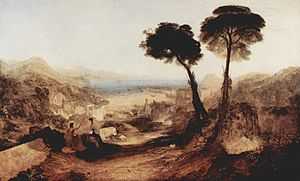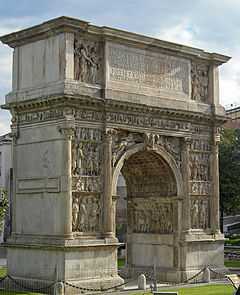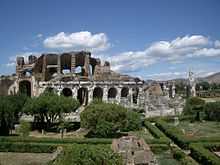Baiae


Baiae (in modern Italian Baia), a frazione of the comune of Bacoli in the Campania region of Italy, was a Roman seaside resort on the Bay of Naples. It was said to have been named after Baius, who was supposedly buried there. Baiae was for several hundred years a fashionable resort, especially towards the end of the Roman Republic. Baiae was even more popular than Pompeii, Herculaneum, and Capri with the super-rich, notorious for the hedonistic temptations on offer, and for rumours of scandal and corruption. Baiae was an integral part of Portus Julius, home port of the western Imperial Fleet of ancient Rome.
Baiae was sacked by Muslim raiders in the 8th century AD and was deserted because of malaria by 1500. Because of coastal subsidence most of Baiae is now under water in the Bay of Naples, largely due to local volcanic activity.[1]
Baiae's medicinal springs
Excavations at the ancient site of Baiae show that the city was host to an important region for thermo-mineral bathing in antiquity. Baiae had been built on the Cumaean peninsula, which was an active volcanic area, known as the Phlegraean Fields, the "fields devoured by fire". Baiae hosted numerous baths filled with warm mineral water directed to pools from sulfur springs underground. Roman engineers were even able to construct a complex system of chambers that channeled heat beneath the land’s surface into bathing facilities that acted as saunas. However, these baths were used not only for relaxation purposes, but often also as medicinal remedies for various illnesses. Roman physicians would often attend their patients at these hot springs.[2]
One of the bathing complexes on the hillside included the Temple of Echo (erroneously, since the seventeenth century, also called the Temple of Mercury[3]) housing a pool. The building was so named for the way sound echoed around the dome, which at about 21.5 m (71 ft) in diameter was the largest dome in the world until the construction of the Pantheon in Rome in 128AD.[4]
Baiae as a resort
The topographical wonders of Baiae, along with the help of Roman engineers, made the city a perfect candidate for a resort for the ultra wealthy. Many elaborate villas were built in Baiae, including those of Julius Caesar and Nero. In fact, a large part of the town became imperial property under Augustus and later emperors—it was often a getaway for the elite with its large swimming pools and its domed casino.[1] It was at his villa near Baiae that the Emperor Hadrian died in AD 138.
References to Baiae in Roman literature
In the trial of Marcus Caelius Rufus in 56 BC, the prominent socialite Clodia was described by the defense as living the life of a harlot in Rome and in the "crowded resort of Baiae", indulging in beach parties and drinking sessions.
Seneca the Younger (4 BC-65 AD) wrote one of his moral epistles on Baiae and Vice, describing the spa town as being a "vortex of luxury" and a "harbor of vice". Sextus Propertius also described the town as a "den of licentiousness and vice" in one of his elegies. Suetonius wrote that a cloak, brooch, and gold bulla given to the young Tiberius Nero (Emperor Tiberius) by Sextus Pompeii's sister, Pompeia, were still on display at Baiae at the time he wrote his history of the twelve emperors
Baiae was also the location for a stunt (in 39 AD) by the eccentric Caligula (Gaius), who on becoming emperor ordered a temporary floating bridge to be built. Roman historian Suetonius writes that the bridge stretched over three miles from the town of Baiae to the neighboring port of Puteoli. It was built using various ships from around the region, upon which sand was poured to make the bridge passable. Clad in a gold cloak, Caligula supposedly then crossed the bridge on his horse in defiance of Roman astrologer Thrasyllus’ prediction that he had "no more chance of becoming emperor than of riding a horse across the Gulf of Baiae." [5] Critics warn that this account is most likely inaccurate, and that Suetonius might have used this legend as a means to criticize Caligula.[6] Roman historian Cassius Dio gives perhaps a more objective explanation of the event, and adds that Caligula had ordered resting places and lodging rooms to be made available along the bridge, complete with drinkable water.[7] It appears that “the act of bridging the Bay of Naples was an excellent - and safe - means by which to lay the foundation for [Caligula’s] military glory.”[6] Some scattered remains were still being shown foreign tourists as the "Bridge of Caligula" at the end of the 18th century: Elizabeth, Lady Holland, in passing by boat from Pozzuoli to Misenum in 1793 thought the remains more likely to have been the mole from which his pontoon bridge was extended.[8]
Baiae as a sculpture workshop
The site of Baiae has occasionally revealed Roman sculptures: an Aphrodite of Baiae supposedly excavated in the site, was purchased before 1803 by the English antiquary and connoisseur Thomas Hope, who displayed it in his gallery in Duchess Street, London. It is a variant of the Venus de Medici.[9] A cache of plaster casts of Hellenistic sculpture has been found in a cellar room of the Baths of Sosandra at Baiae and is now on display in the Museo Archeologico dei Campi Flegrei at Baiae.[10] It suggests a workshop mass-producing marble or bronze copies of Hellenistic and Greek sculptures for the Roman market from bronze original sculptures. These casts include parts of many famous sculptures such as the Harmodius and Aristogeiton.[11] and the Athena of Velletri.
Reference to Baiae in modern literature
One of the few references to Baiae in modern literature is the short story "The Procurator of Judea" (original French title "Le Procurateur de Judée") by Anatole France (1902).
In "one of his last and finest poems," Konstantin Batyushkov "laments the beauty of the ancient world now vanished forever as he views the porphyry columns of an ancient city inundated by the sea, a city destined never to appear to men's eyes again ('You awake, oh Baia, from the tomb...' ['Ty probuzhdaeshsya, o Bayya, iz grobnitsy...'], 1819)."[12]
In Percy Bysshe Shelley's poem "Ode to the West Wind," stanza III includes the line: "Beside a pumice isle in Baiae's bay."
Baiae is referenced as a place of worship of the goddess Maia in John Keats's poem "Ode to May. Fragment."
Baiae is the site of a murder in the mystery Under the Shadow of Vesuvius by John Maddox Roberts, episode 11 in his SPQR series, featuring Decius Caecilius Metellus.
The Roman emperor Hadrian makes several trips to the Baiae, including his last, in Marguerite Yourcenar's Memoirs of Hadrian.
In The Lost Stradivarius (1895) of J. Meade Falkner, the dying and haunted protagonist maintains a villa full of priceless works of art near Baiae, "the princely seaside resort of the empire." "That most luxurious and wanton of all cities of antiquity ... is still instinct with memories of a shameful past."
Also in Caroline Lawrence's Roman Mysteries series, the eleventh book, The Sirens of Surrentum, is set nearby Baiae. It is portrayed as a glirarium of licentiousness.
In the Latin textbooks Ecce Romani, Baiae is the place where Gaius Cornelius Calvus and his family have their summer villa. Baiae is represented as a place where the wealthy would live, and the Cornelians go on to live in the city.
Steven Saylor's detective novel Arms of Nemesis (1992) featuring Gordianus the Finder unfolds in Baiae, at the time of the Spartacus rebellion.
See also
- List of Roman cisterns
- List of Roman domes
- Compare Monte Carlo in the 20th century.
- Fusaro Lake
Notes
- ↑ 1.0 1.1 "Baiae", Encyclopædia Britannica Online, retrieved 28 April 2007
- ↑ Yegül, Fikret K. "The Thermo-Mineral Complex at Baiae and De Balneis Puteolanis." The Art Bulletin 78.1 (1996): 137-61.
- ↑ The thermo-mineral complex at Baiae and De Balneis Puteolanis
- ↑ R. Mark and P. Hutchinson, "On the Structure of the Roman Pantheon", Art Bulletin 68, March 1986, p.24; The Ancient Baths of Baiae
- ↑ C. Suetonius Tranquillius. "Caius Caesar Caligula." The Lives of the Twelve Caesars.
- ↑ 6.0 6.1 Malloch, S. J. V. "Gaius' Bridge at Baiae and Alexander-Imitatio." The Classical Quarterly 51.1 (2001): 206-17.
- ↑ Cassius Dio. "Book LIX." Roman History.
- ↑ Lord Ilchester, ed., The Journal of Elizabeth Lady Holland: (1791-1811) 1908:23.
- ↑ Geoffrey B. Waywell, Raoul Laev, The Lever and Hope sculptures: ancient sculptures in the Lady Lever Art Gallery, Port Sunlight, and a catalogue of the ancient sculptures formerly in the Hope Collection, London and Deepdene 1986:41 and fig. 11.
- ↑ Corpus Vasorum Antiquorum.
- ↑ Beazley Archive.
- ↑ Mark Altshuller, "The transition to the modern age: Sentimentalism and preromanticism, 1790–1820," in Charles Moser (ed.), The Cambridge History of Russian Literature, rev. ed. (Cambridge University Press, 1992; ISBN 0521425670), p. 127.
Bibliography
| Wikisource has the text of the 1911 Encyclopædia Britannica article Baiae. |
- Paolo Amalfitano et al., I Campi Flegrei Venice 1990.
- Fabio Maniscalco, Ninfei ed edifici marittimi severiani del Palatium imperiale di Baia, Naples, 1997.
- Piero Alfredo Gianfrotta, Fabio Maniscalco (eds.), Forma Maris. Forum Internazionale di Archeologia Subacquea, Puteoli, 1998.
- Puteoli. Studi di Storia Romana.
- Baia: the castle, museum and archaeological sites, 2003.
Coordinates: 40°49′00″N 14°04′11″E / 40.81667°N 14.06972°E
| ||||||||||||||||||||||||


